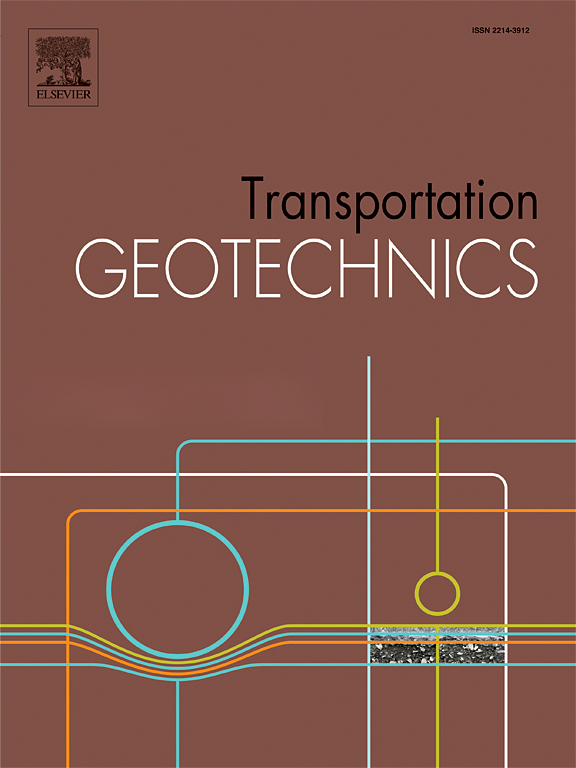Sensitivity Analysis of Factors that Induce Road Collapses Due to Drainage Pipe Leakage and Traffic Load
IF 5.5
2区 工程技术
Q1 ENGINEERING, CIVIL
引用次数: 0
Abstract
At persent, quantitatively assessing the sensitivity of disaster-causing factors in road collapses remains challenging using conventional methodologies. This study establishes a physical model test system for road collapse to investigate the evolution of cavity buried depth, equivalent diameter, road settlement, soil stress/settlement, and drainage density/flow under various traffic loads. A deep-learning backbone is created that integrates a convolutional neural network (CNN), bidirectional short-term memory (BiLSTM), attention mechanisms, and the Sobol method (CBAS). This model is applied to three functional units, including data generation, settlement prediction, and sensitivity analysis. The findings show that the buried depth of a cavity decreases exponentially over time, whereas the equivalent diameter of the cavity follows a power-law increase. The drainage density and flow demonstrate fluctuating characteristics, whereas the abrupt increase in soil settlement exhibits a “time lag” effect relative to the sudden surge in soil stress. Notably, the buried depth and equivalent diameter of the cavity are highly sensitive to road settlement, whereas the sensitivity of soil settlement to road settlement varies. By contrast, the sensitivities of soil stress, drainage density, and drainage flow to road settlement are relatively weak. The validity of the CNN–BiLSTM–ATTENTION backbone was verified using root mean square error, mean absolute percentage error, and mean absolute percentage error performance metrics. The CBAS’ sensitivity analysis results were validated using the extended Fourier amplitude sensitivity test. The study findings provide valuable insights for monitoring and early warning of road collapses.
排水管道渗漏及交通荷载诱发道路塌陷因素敏感性分析
目前,使用传统方法定量评估道路塌陷中致灾因素的敏感性仍然具有挑战性。建立道路塌陷物理模型试验系统,研究不同交通荷载作用下洞室埋深、等效直径、道路沉降、土体应力/沉降、排水密度/流量的演变规律。将卷积神经网络(CNN)、双向短期记忆(BiLSTM)、注意力机制和Sobol方法(CBAS)集成在一起,创建了一个深度学习骨干。该模型应用于数据生成、沉降预测和敏感性分析三个功能单元。结果表明,空腔埋深随时间呈指数递减,而等效直径则呈幂律递增。排水密度和流量表现出波动特征,而土体沉降的突然增加相对于土体应力的突然激增表现出“时滞”效应。值得注意的是,洞室埋深和等效直径对道路沉降高度敏感,而土壤沉降对道路沉降的敏感性各不相同。而土体应力、排水密度、排水流量对道路沉降的敏感性相对较弱。采用均方根误差、平均绝对百分比误差和平均绝对百分比误差性能指标验证CNN-BiLSTM-ATTENTION骨干网的有效性。采用扩展傅立叶振幅灵敏度试验验证了CBAS的灵敏度分析结果。研究结果为道路塌陷的监测和预警提供了有价值的见解。
本文章由计算机程序翻译,如有差异,请以英文原文为准。
求助全文
约1分钟内获得全文
求助全文
来源期刊

Transportation Geotechnics
Social Sciences-Transportation
CiteScore
8.10
自引率
11.30%
发文量
194
审稿时长
51 days
期刊介绍:
Transportation Geotechnics is a journal dedicated to publishing high-quality, theoretical, and applied papers that cover all facets of geotechnics for transportation infrastructure such as roads, highways, railways, underground railways, airfields, and waterways. The journal places a special emphasis on case studies that present original work relevant to the sustainable construction of transportation infrastructure. The scope of topics it addresses includes the geotechnical properties of geomaterials for sustainable and rational design and construction, the behavior of compacted and stabilized geomaterials, the use of geosynthetics and reinforcement in constructed layers and interlayers, ground improvement and slope stability for transportation infrastructures, compaction technology and management, maintenance technology, the impact of climate, embankments for highways and high-speed trains, transition zones, dredging, underwater geotechnics for infrastructure purposes, and the modeling of multi-layered structures and supporting ground under dynamic and repeated loads.
 求助内容:
求助内容: 应助结果提醒方式:
应助结果提醒方式:


